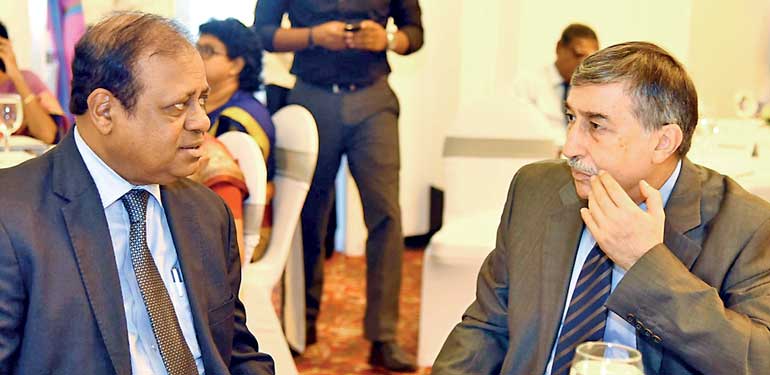Thursday Nov 14, 2024
Thursday Nov 14, 2024
Thursday, 29 June 2017 00:00 - - {{hitsCtrl.values.hits}}
 Science, Technology and Research Minister Susil Premajayantha in discussion with Russian Ambassador to Sri Lanka Alexander Karchava – Pic by Kithsiri de Mel
Science, Technology and Research Minister Susil Premajayantha in discussion with Russian Ambassador to Sri Lanka Alexander Karchava – Pic by Kithsiri de Mel
By Madushka Balasuriya
With precisely six months remaining until a partial ban on asbestos controlling its import and use comes into effect in the country, roofing sheet industry leaders yesterday claimed that the Government was yet to clarify what exactly such a ban would entail.
“There are no instructions from the Government so far regarding what is going to happen in 2018, nor the complete ban in 2024. But in any case, we have been practising the safe use of asbestos for a very long time so we’re not afraid of any regulations or anything like that,” they told reporters.
“As for 2018 though, what the Government’s going to do, I don’t think that even they know. They have convened committees but that’s the extent of it,” said Fibre Cement Product Manufacturers Association (FCPMA) Coordinator Anton Edema at a conference in Colombo.
Edema was speaking at the launch of a new website (www.chrysotile.lk) and report titled ‘Socio Economic Impact of the Potential Ban on Chrysotile Fibre Roofing Products in Sri Lanka - Cost Evaluation’ which was compiled by private research firm, Research Intelligence Unit (RIU).
True to its title, the report proffers several cost estimates surrounding the proposed ban. The Chrysotile Information Centre said that they have commissioned three more reports, including an analysis on potential health impacts.
In terms of direct costs, a complete ban is estimated to result in a loss of Rs. 858 million to Customs and Inland Revenue, an estimated Rs. 14.7 billion loss of income and profits to the roofing sheet industry, and an estimated Rs. 17.9 billion loss in income earned by employees, among other things.
Moreover, it posits that a majority of the countries that have banned Chrysotile - a type of asbestos industry leaders claim is not harmful to humans - are “predominantly located in Europe and a few other parts of the industrialised world where the average GDP is almost 10 times higher than Sri Lanka.”
This analysis ties in with industry leaders’ views that what is good for the West might not necessarily be the best solution for developing nations such as Sri Lanka. Typically low-income households aspire to have asbestos roofing, as at present they have iron-corrugated sheets. If asbestos is removed from the equation these households could be stuck in a situation where the next best alternative is too expensive, the report states.
At present the only realistic alternatives are synthetic fibres, metal roofing or clay tiling, all of which are more expensive than asbestos. On top of this, the report estimates the cost of investment to produce alternatives could reach anywhere between Rs. 8 billion and Rs. 16 billion.
Technology and Research Minister Susil Premajayantha, speaking at the same event, revealed that he was awaiting reports on the matter from the Industrial Technology Institute (ITI) after he had been moved to further research claims being made by players in the roofing sheet industry over the safe use of Chrysotile. Premajayantha added that he would also look at formulating further reports on the matter.
“Recently I met some of the business personnel involved with Chrysotile roofing sheets regarding the ban, which saw Sri Lanka follow the lead of some 50 countries including Australia and New Zealand.
“After that I referred the matter to ITI, and am awaiting the reports. I can also direct one of our scientific research institutions to look at the available data to submit another report on this issue.”
By way of attempting to explain the Government’s hardline stance on asbestos in the face of compelling evidence from its proponents, Premajayantha explained that policymakers were only working with the data available to them, which can lead to them being mislead.
“Policymakers are making policy decisions based on the data and information available, but there are times when someone can mislead policymakers. There are instances like that. Even today you find there are social issues, with protests on the street, where policymakers have different views,” he said.
Since 1987, the importation of blue asbestos (Crocidolite) has been prohibited as it was identified as a carcinogen by the World Health Organization (WHO). At present all kinds of asbestos, including white asbestos (Chrysotile), have been identified as carcinogens. The FCPMA however argues that this is due to the fact that the WHO has grouped all asbestos types together, adding that there is no evidence supporting a ban on Chrysotile.
This is echoed in the report, which states: “To date there are no medical records or statistics showing harm from the import or manufacture of Chrysotile containing roofs despite more than sixty years of use in Sri Lanka.”